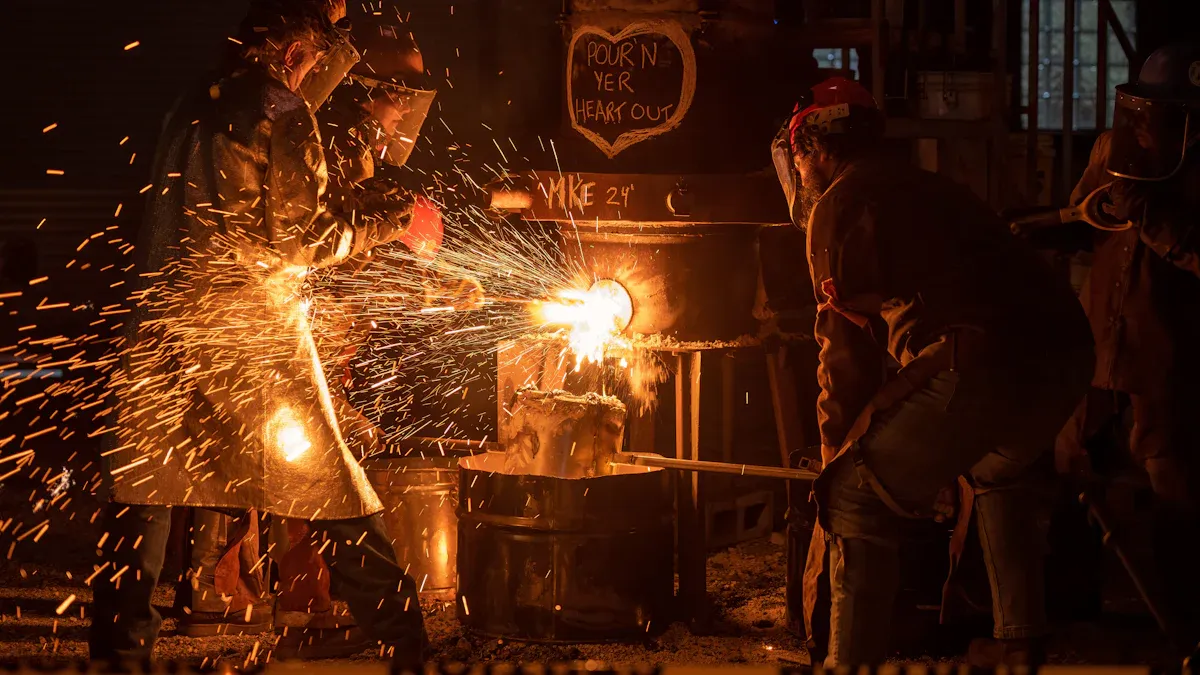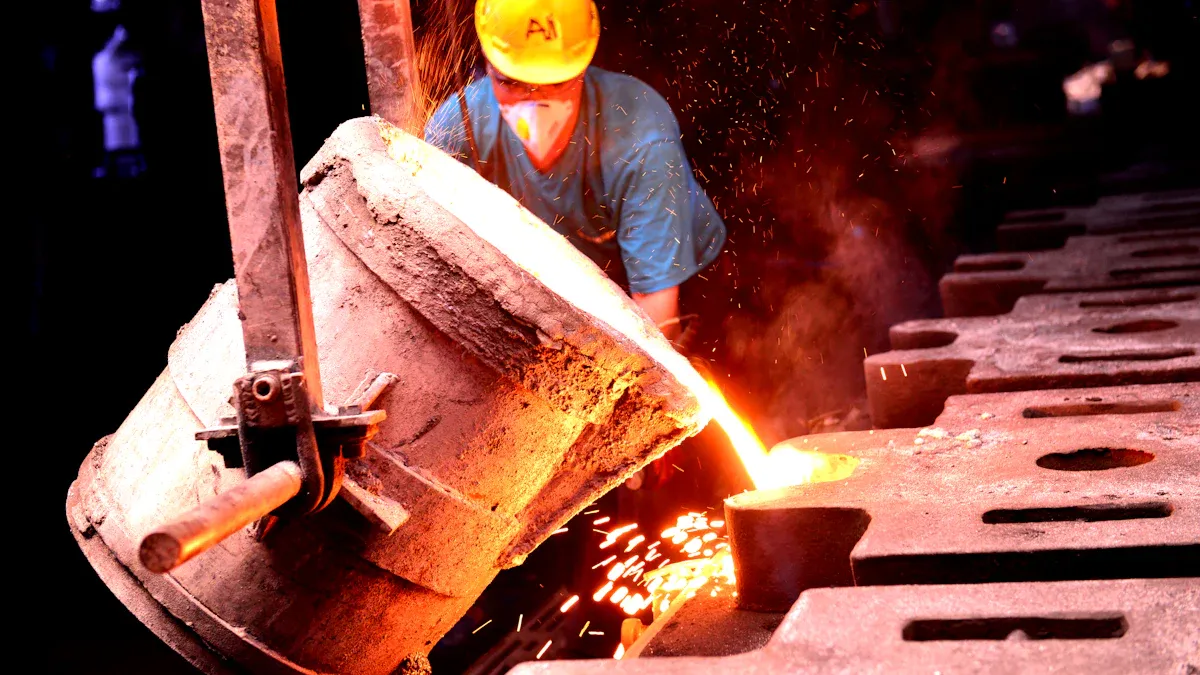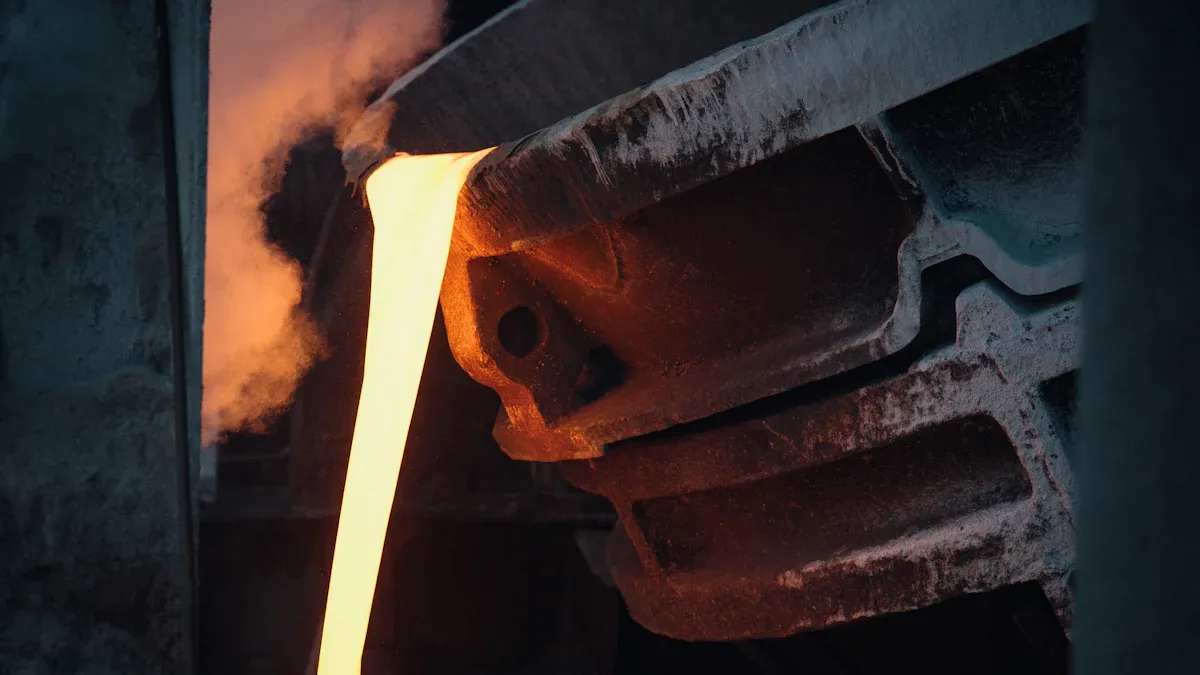
When handling molten metals, material selection becomes critical. SiC Coating, made from silicon carbide, offers a high-performance surface layer. Traditional ceramics, on the other hand, rely on their natural heat resistance. You’ll find both used in industrial processes to protect equipment. But which performs better under extreme conditions? Let’s explore the comparison.
Key Takeaways
- SiC Coating handles heat better and spreads it faster, perfect for hot uses.
- SiC Coating lasts longer and stays strong under stress, unlike regular ceramics.
- In reactive metal settings, SiC Coating stays stable and avoids damage or mixing.
Key Performance Metrics of SiC Coating and Traditional Ceramics

Thermal Resistance and Heat Conductivity
When working with molten metals, thermal resistance becomes a critical factor. SiC Coating excels in this area due to its ability to withstand extreme temperatures without degrading. Silicon carbide has a high melting point, making it ideal for applications where heat exposure is constant. You’ll find that SiC Coating also offers superior heat conductivity, allowing it to dissipate heat more efficiently. This property reduces the risk of thermal stress and cracking, which can compromise equipment integrity.
Traditional ceramics, while known for their heat resistance, often fall short in heat conductivity. They tend to retain heat rather than distribute it evenly. This characteristic can lead to localized overheating, which may weaken the material over time. If your application requires consistent thermal performance, SiC Coating provides a clear advantage.
Durability and Wear Resistance
Durability plays a vital role in molten metal applications. SiC Coating stands out with its exceptional hardness and wear resistance. Silicon carbide ranks high on the Mohs scale, meaning it resists scratches, abrasions, and mechanical wear. This durability ensures a longer lifespan for equipment exposed to harsh conditions.
Traditional ceramics, while durable, are more prone to chipping and cracking under mechanical stress. Their brittleness can become a liability in environments where impact or abrasion is common. If you need a material that can endure heavy use without frequent maintenance, SiC Coating offers a more reliable solution.
Chemical Stability in Molten Metal Environments
Molten metals often contain reactive elements that can corrode or degrade protective materials. SiC Coating demonstrates remarkable chemical stability, even when exposed to aggressive molten metal environments. Its inert nature prevents chemical reactions that could weaken the coating or contaminate the metal.
Traditional ceramics, on the other hand, may not offer the same level of chemical resistance. Some ceramic materials can react with molten metals, leading to erosion or contamination. If your process involves highly reactive metals, SiC Coating ensures better protection and performance.
Comparative Analysis of SiC Coating and Traditional Ceramics
Strengths and Weaknesses of Each Material
When comparing SiC Coating and traditional ceramics, you’ll notice distinct strengths and weaknesses in both materials. SiC Coating offers exceptional thermal conductivity, chemical stability, and wear resistance. These qualities make it ideal for high-temperature environments where durability is critical. Its ability to resist chemical reactions ensures that it performs well in aggressive molten metal conditions.
However, SiC Coating can be more expensive to produce and apply. The advanced manufacturing processes required for its application may not always suit smaller-scale operations.
Traditional ceramics, on the other hand, are widely available and cost-effective. They provide reliable heat resistance and are easier to source for many industrial applications. Yet, their brittleness and lower chemical stability can limit their performance in demanding environments. If your process involves frequent mechanical stress or exposure to reactive metals, traditional ceramics may not hold up as well as SiC Coating.
Real-World Performance Data
In real-world applications, SiC Coating consistently outperforms traditional ceramics in terms of longevity and reliability. For example, industries handling molten aluminum or steel often report fewer failures and longer equipment lifespans when using SiC Coating. Its superior thermal conductivity helps prevent localized overheating, reducing the risk of cracks or material degradation.
Traditional ceramics, while effective in less demanding scenarios, tend to show wear more quickly in high-stress environments. Studies have shown that ceramic linings in molten metal containers often require replacement after shorter intervals compared to SiC-coated surfaces. This difference highlights the importance of matching the material to the specific demands of your application.
Tip: If you’re working in an environment with extreme temperatures and reactive metals, SiC Coating provides a more reliable and long-lasting solution.
Maintenance and Longevity Considerations
Maintenance requirements can significantly impact the overall cost and efficiency of your operations. SiC Coating requires minimal upkeep due to its durability and resistance to wear. Its smooth surface also reduces the buildup of metal residues, making cleaning easier and less frequent.
Traditional ceramics, while durable in certain conditions, often demand more frequent maintenance. Their tendency to chip or crack under stress means you may need to replace or repair them more often. This can lead to higher downtime and increased operational costs over time.
If you prioritize long-term performance and reduced maintenance, SiC Coating offers a clear advantage. Its ability to withstand harsh conditions ensures that your equipment remains operational for longer periods, saving you time and resources.
Practical Applications of SiC Coating and Traditional Ceramics

SiC Coating in High-Temperature Molten Metal Handling
SiC Coating excels in environments where extreme heat and reactive metals are present. You’ll often find it used in industries like aluminum smelting, steel casting, and glass manufacturing. Its ability to resist thermal shock makes it ideal for components like crucibles, molds, and furnace linings. The smooth surface of SiC Coating also minimizes metal adhesion, which simplifies cleaning and reduces downtime.
Did you know? SiC Coating can handle temperatures exceeding 2,700°F, making it one of the most heat-resistant materials available for industrial use.
If your operation involves frequent exposure to molten metals, SiC Coating ensures consistent performance and longer equipment life. Its chemical stability also prevents contamination, which is critical for maintaining product quality.
Traditional Ceramics in Industrial Processes
Traditional ceramics play a vital role in many industrial applications. You’ll see them used in kiln linings, refractory bricks, and insulation materials. Their affordability and availability make them a popular choice for less demanding environments. For example, ceramics work well in processes where heat resistance is needed but mechanical stress is minimal.
However, traditional ceramics may not perform as well in high-impact or chemically aggressive settings. Their brittleness can lead to cracking, especially under sudden temperature changes. If your process involves moderate heat and limited mechanical wear, traditional ceramics offer a cost-effective solution.
Scenarios Where One Material Outperforms the Other
Choosing between SiC Coating and traditional ceramics depends on your specific needs. SiC Coating outshines in high-temperature, high-stress environments. For instance, it’s the better choice for handling molten aluminum or steel due to its durability and chemical resistance.
Traditional ceramics, on the other hand, are more suitable for applications with lower thermal and mechanical demands. For example, they work well in kiln furniture or as insulating layers in furnaces.
| Scenario | Best Material |
|---|---|
| High-temperature molten metal | SiC Coating |
| Moderate heat, low stress | Traditional Ceramics |
| Reactive metal environments | SiC Coating |
| Cost-sensitive applications | Traditional Ceramics |
Tip: Evaluate your operational requirements carefully. The right material can save you time, money, and maintenance headaches.
Cost and Scalability of SiC Coating and Traditional Ceramics
Initial Investment and Material Costs
When comparing costs, you’ll notice that SiC Coating typically requires a higher initial investment. The advanced manufacturing processes and specialized equipment needed for its application contribute to this expense. Additionally, silicon carbide itself is a premium material, which adds to the upfront cost.
Traditional ceramics, on the other hand, are more budget-friendly. Their widespread availability and simpler production methods make them a cost-effective choice for many industries. If your project has a tight budget, traditional ceramics may seem like the better option at first glance.
Note: While SiC Coating costs more initially, its performance benefits often justify the expense in demanding applications.
Long-Term Cost-Effectiveness
Over time, SiC Coating proves to be a more cost-effective solution. Its durability and resistance to wear reduce the need for frequent replacements. You’ll spend less on maintenance and downtime, which can significantly lower operational costs.
Traditional ceramics, while cheaper upfront, may require more frequent repairs or replacements. Their brittleness and susceptibility to chemical reactions can lead to higher long-term expenses. If you’re looking for a material that minimizes recurring costs, SiC Coating offers better value.
Scalability and Industrial Implementation
Scaling up with SiC Coating can be challenging due to its specialized application process. Industries with large-scale operations may face higher costs and longer lead times when implementing this material. However, its superior performance often offsets these challenges in high-demand environments.
Traditional ceramics are easier to scale. Their simpler production and application processes make them a practical choice for industries requiring large quantities. If scalability is a priority, traditional ceramics provide a more straightforward solution.
Tip: Consider your operational scale and performance needs. SiC Coating excels in demanding environments, while traditional ceramics shine in cost-sensitive, large-scale applications.
SiC coatings outperform traditional ceramics in durability, chemical stability, and heat conductivity. You’ll find them ideal for high-temperature and reactive metal environments. Traditional ceramics work better in cost-sensitive applications with moderate stress.
Recommendation: Choose SiC coatings for demanding processes. Opt for traditional ceramics when affordability and scalability matter most.
FAQ
What makes SiC Coating more durable than traditional ceramics?
SiC Coating resists wear and mechanical stress due to its hardness. Its structure prevents cracking and chipping, even in high-impact environments.
Can traditional ceramics handle reactive molten metals?
Traditional ceramics may react with certain molten metals. This reaction can cause erosion or contamination. SiC Coating offers better chemical stability in such environments.
Is SiC Coating worth the higher cost?
Yes, for demanding applications. Its durability and low maintenance reduce long-term costs. You save money on replacements and downtime.
Tip: Evaluate your operational needs. SiC Coating suits high-stress environments, while traditional ceramics work well for cost-sensitive projects.


